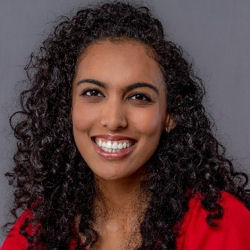
Rachana Raghupathy
Physician Well-being and Professional Fulfillment Committee
— MEDICAL SCHOOL —
Northeast Ohio Medical University
— GRADUATING CLASS —
2022

Emily Lee
— MEDICAL SCHOOL —
Virginia Commonwealth University School of Medicine
— GRADUATING CLASS —
2021
Studies have shown that a majority of medical students have a more negative perception of lesbian and gay people than they do heterosexual people (1, 2). Perceived discrimination from health care providers and denial of health care altogether are common experiences among LGBTQ+ patients, which contributes to health disparities. As our social landscape changes, many medical institutions are evaluating how they can address this issue. For example, Northeast Ohio Medical University in Rootstown, Ohio, invited members of the local LGBTQ+ community to speak on their own experiences with health care professionals—the good, the bad, and the ugly. Many of the trans patients who attended the session cited the tactlessness of their physicians when discussing particular sensitive topics, such as sexual health or past medical procedures. Students learned how poor word choice and composure during such delicate conversations can seed mistrust toward not only the physician but also the health care system as a whole. They also learned how important it is to acknowledge the weight of our words and how our patients may perceive our unconscious behaviors.
Many studies acknowledge the role of implicit bias in exacerbating health outcomes (3-5). Patients affected are predominantly racial and ethnic minorities, individuals who identify on the LGBTQ+ spectrum, women (especially women of color), and individuals who are disabled. Negative outcomes range from higher morbidity and mortality rates to reports of lower satisfaction in the quality of healthcare delivered.
The consequence of unconscious bias in healthcare stems from early on in medical training. A New England Journal of Medicine perspective by Harvard Medical Student LaShyra Nolen titled “How Medical Education Is Missing the Bull's-eye” reflects that the medical education system has been disproportionately (and in many cases unconsciously) representing the heterogeneity of the general population within medical teachings, whether through mannequins used in CPR training or discussions of variation in presentation of infectious skin rashes on different skin tones (6).
We should therefore reform medical school curricula to include opportunities for students to think critically about implicit biases, their consequences to patient care, and strategies to mitigate their impact. These changes are imperative for both the education of the student and optimal care of patients.
An important first step to change implicit bias is to identify the biases present. Such tools as the implicit association test (IAT) are used across medical schools to better understand one's own social biases as a starting point to minimize their effects.
Group discussions are also important for facilitating critical self-reflection on power and privilege while considering solutions to address implicit biases in health care. These conversations can occur multiple times per year and should try to feature minority community members who can share their experiences on their minority status and health care delivery. Activities such as this can foster introspection on how to approach such patients with confidence while also acknowledging the importance of being sensitive to the patients' experience. Ultimately, this will not only instill within patients a sense of trust in their providers but also lead to better adherence to treatment plans and improved perceived quality of care.
For example, in order to address a diverse patient population and gain knowledge of disease presentation across skin types and colors as addressed in Ms. Nolen's article, such resources as BrownSkinMatters and VisualDx may be used (7). Professors may consider adding information or images to their teaching material to instruct students on physical variations in presentation. In addition, instructors can encourage students to practice their physical examination techniques and basic life support skills on a variety of individuals and mannequins of different sex, size, skin color, and other factors.
Unfortunately, although vital to address this issue early in medical training, many of these changes cannot happen overnight. It will take advocacy, persistence, and perseverance.
Students, contact your school's curriculum committee and start a conversation on changes or adjustments that could help address this issue—no request is too small. Gather your peers to brainstorm ideas of changes you would like to see, whether extensions of the ideas listed here or some of your own. Use your voice to shape your education.
Medical school faculty and curriculum advisers, please understand how important your role is in addressing these implicit biases and ensuring the best care possible for future patients. If you feel that your current curriculum does not provide adequate education on the topic of bias in health care, please consider adjusting your curriculum to better prepare students to care for the heterogeneous patient population they will inevitably see in the future.
To all of our readers, please take the time to recognize your voice. Understand the power you have to change your own implicit biases, as well as those within your circle. Continue to challenge each other to identify where implicit biases may be taking hold in your everyday life, continue to educate yourself on the topic, and continue to listen and reflect. Change does take time. Be patient.
References
- Burke SE, Dovidio JF, Przedworski JM, et al. Do contact and empathy mitigate bias against gay and lesbian people among heterosexual first-year medical students? A report from the medical student CHANGE study. Acad Med. 2015;90:645-51. [PMID: 25674910] doi:10.1097/ACM.0000000000000661
- Morris M, Cooper RL, Ramesh A, et al. Training to reduce LGBTQ-related bias among medical, nursing, and dental students and providers: a systematic review. BMC Med Educ. 2019;19:325. [PMID: 31470837] doi:10.1186/s12909-019-1727-3
- Choi K, Shofer FS, Mills AM. Sex differences in STEMI activation for patients presenting to the ED 1939. Am J Emerg Med. 2016;34:1939-43. [PMID: 27425140] doi:10.1016/j.ajem.2016.06.082
- Lawrence D, Kisely S. Inequalities in healthcare provision for people with severe mental illness. J Psychopharmacol. 2010;24:61-8. [PMID: 20923921] doi:10.1177/1359786810382058
- Leonard SA, Main EK, Scott KA, et al. Racial and ethnic disparities in severe maternal morbidity prevalence and trends. Ann Epidemiol. 2019;33:30-6. [PMID: 30928320] doi:10.1016/j.annepidem.2019.02.007
- Nolen L. How medical education is missing the bull's-eye. N Engl J Med. 2020;382:2489-91. [PMID: 32579809] doi:10.1056/NEJMp1915891
- Woo M. See what children’s rashes look like on darker skin with ‘Brown Skin Matters.’ Lifehacker. 15 August 2019. Accessed at https://offspring.lifehacker.com/see-what-childrens-rashes-look-like-on-darker-skin-with-1837261047 on July 30, 2020.
Back to the September 2020 issue of ACP IMpact

